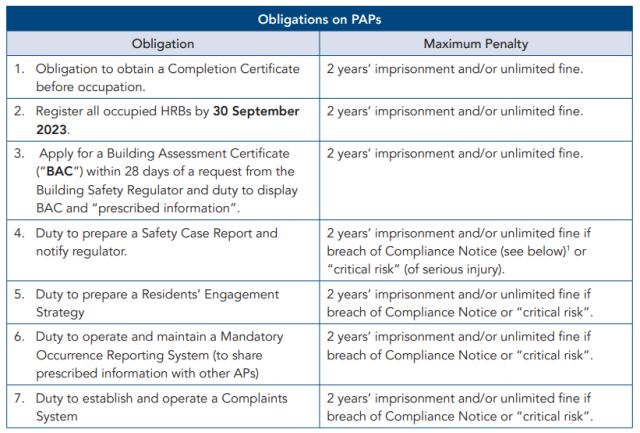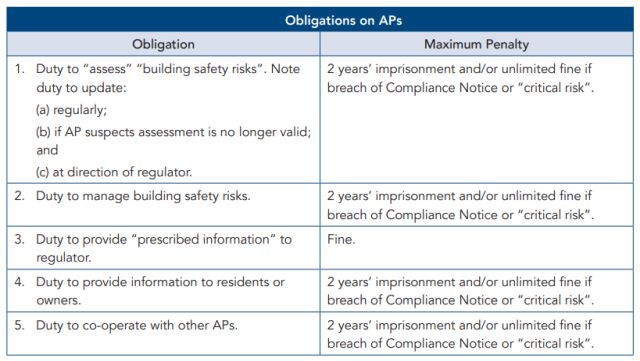The BSA is the main piece of legislation setting out the Government's response to the Grenfell tragedy. The BSA introduces new rules to ensure the safety of taller buildings in the design and construction phase and in the so-called “in-occupation” phase. In this Alert we summarise the new rules for the in-occupation phase. The regime applies to all occupied higher risk buildings (“HRB's”), including existing buildings.
The key requirement to register existing HRBs needs to be complied with by 30 September 2023. Failure to comply is a criminal offence.
What buildings does the In-Occupation regime apply to?
Tall buildings
The regime applies to new and existing occupied HRB's. These are buildings:
- of at least 18 metres in height or at least 7 storeys (excluding underground storeys); and
- containing at least 2 residential units.
Excluded uses
Certain buildings of a residential-type use are excluded: care homes, hotels and hospitals (amongst others) where the entire building falls into one of the excluded uses.
You should note that, although buildings used exclusively as hotels are excluded from the regime, serviced apartments (or apart-hotels) are considered to be HRBs. This is the case even though the serviced accommodation may benefit from planning permission under Class C1 of the Use Classes Order (which is the hotel Use Class). The term “serviced apartments” is not defined in the legislation or the supporting guidance and a cautious approach may need to be taken when relying on the exclusion for hotels where any element of servicing is provided.
Mixed Uses, “independent sections” and adjoining buildings
As the result of being able to be a HRB because of only having 2 residential units, mixed use buildings potentially need to be registered. So, for example, a building which is primarily a hotel (of, say, 10 floors) with two penthouse residential units at floors 9 and 10 falls, in principle, within the regime so that the whole building (not just the residential element) is covered.
That said, where a structure contains “independent sections” each independent section is regarded as a separate building.
To assess whether part of a structure is an “independent section” you should consider whether it:
- has its own entrance and exit to the outside; and
- whether it has no access to the rest of the structure or only has access to another section of the Structure which does not contain a residential unit.
Similarly, adjoining structures are regarded as a single building regardless of ownership unless they are independent sections.
What are the main obligations under the regime and who do they apply to?
Part 4 of the BSA which sets out the in-occupation regime, imposes obligations on every Accountable Person (“AP”) and the Principal Accountable Person (“PAP”) in respect of every occupied HRB.
In summary, an AP is any person with a repairing obligation in respect of any common parts of the building. The PAP is the AP for buildings with only one AP, and for buildings with more than one AP, the PAP is the AP with responsibility for repairing the structure and exterior of the building.
Where there is a dispute about who is the PAP, this can be referred to a tribunal for determination.
The main obligations on APs and PAPs and the maximum penalties for failure to comply with them are:

As noted above, the regulator has the power to issue a Compliance Notice requiring remedial steps to be undertaken by the AP within a specified timeframe where the regulator considers an AP has breached one of its obligations. Failure to comply with the notice within the specified time period is a criminal offence.
Furthermore, a breach of an obligation is a criminal offence where it gives rise to a “critical risk” which is a significant risk of serious injury or death, whether or not a Compliance Notice has been served.
In addition, to the above duties, all APs are subject to the following duties.

It should be noted that the duty to assess building safety risk is both ongoing and covers a broader range of risks than fire risk: it includes any risk of “structural failure”. This will, for instance, include any risks associated with reinforced autoclaved aerated concrete (“RAAC”).
Duties on Occupiers and Contravention Notices
The BSA acknowledges that fire risks can be exacerbated by the acts or omissions of occupiers. For this reason, certain duties are also placed on residents and owners of residential units.
Specifically, residents and owners:
- must not act in a way that creates a significant risk or a building safety risk materialising;
- must not interfere with any building “safety item” (e.g. extinguishers or alarms); and
- must comply with requests for information by an AP.
In the event that a resident or owner breaches any of these duties, the relevant AP may serve a Contravention Notice on them requiring the breach to be remedied within a given period or sums to be paid when the AP rectifies the breach.
Similarly, an AP may request access to any premises forming part of a building to which the in-occupation regime applies for the purpose of carrying out its duties. A County Court may issue an order granting access if it considers this appropriate.
Implied Terms in Leases
In order to facilitate compliance with the various obligations in the BSA, the following terms are implied into residential leases:
- a duty on the Landlord (where he is an AP) to comply with its obligations under the BSA;
- a duty by the Landlord and Tenant each to comply with their statutory obligations under the BSA; and
- a duty on the Tenant to allow the Landlord (AP) access to the premises for the purpose of carrying out its duties.
In addition, in leases of 7 years or more, under which the Tenant is liable to pay a service charge, the Tenant is liable to pay a proportion of the Landlord (AP's) costs of complying with its obligations including “reasonable steps” to comply with its duty to manage building safety risks.
The Landlord (AP) may not recover any costs associated with financial penalties for its failure to comply with its duties from Tenants.
Conclusion
The Grenfell Inquiry found that the legal regime for ensuring the safety of tall buildings was unfit for purpose. The main criticism of the former regime was that responsibility for managing risk was unclear and overlapping, that occupiers had no voice and that enforcement was inadequate.
The Government has sought to respond to these criticisms by introducing a clearer hierarchy of responsibilities, backed by tougher penalties and a formal seat at the table in the making of building safety decisions for residents.
Footnote
1. Requests for BACs will be made as from April 2024.
Visit us at mayerbrown.com
Mayer Brown is a global services provider comprising associated legal practices that are separate entities, including Mayer Brown LLP (Illinois, USA), Mayer Brown International LLP (England & Wales), Mayer Brown (a Hong Kong partnership) and Tauil & Chequer Advogados (a Brazilian law partnership) and non-legal service providers, which provide consultancy services (collectively, the "Mayer Brown Practices"). The Mayer Brown Practices are established in various jurisdictions and may be a legal person or a partnership. PK Wong & Nair LLC ("PKWN") is the constituent Singapore law practice of our licensed joint law venture in Singapore, Mayer Brown PK Wong & Nair Pte. Ltd. Details of the individual Mayer Brown Practices and PKWN can be found in the Legal Notices section of our website. "Mayer Brown" and the Mayer Brown logo are the trademarks of Mayer Brown.
© Copyright 2023. The Mayer Brown Practices. All rights reserved.
This Mayer Brown article provides information and comments on legal issues and developments of interest. The foregoing is not a comprehensive treatment of the subject matter covered and is not intended to provide legal advice. Readers should seek specific legal advice before taking any action with respect to the matters discussed herein.

